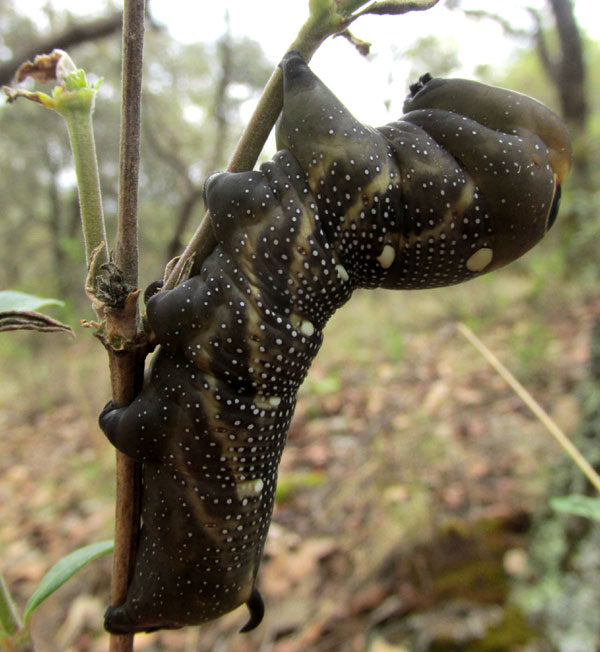Excerpts from Jim Conrad's
Naturalist Newsletter
entry from field notes dated July 3, 2022, taken in oak forest on slopes of Cerro de la Cruz, elevation ~2700m (~8850 ft), rising on the south side of the community of El Pinar, Amealco de Bonfil, Querétaro, MÉXICO, (~N20.17°, ~W100.17°)
FALCON SPHINX CATERPILLAR

On the chilly, droughty northern slope of Cerro de la Cruz, I was surprised to see the above hornworm chewing away the bottom of a red Bouvardia ternifolia flower, that small bush being a member of the Madder or Coffee Family, the Rubiaceae. In the picture's background you can see how crispy dry the forest floor is; The rainy season just isn't coming when it should.
Being so plump, about the length of my longest finger, and bearing the curved little "tail" at its rear end, this is a kind of "hornworm." Hornworms belong to the big Sphinx Moth Family, the Sphingidae, which embraces around 1,100 species of medium to large, often colorful moth species. Sphinx moth species, in the winged, adult form, typically are fast and strong fliers, with rapid wing beats. Many hover in midair as they feed on nectar from flowers, and may be mistaken for hummingbirds or big bees.

Probably the main defense the big, juicy caterpillars have against being eaten by birds is their camouflage. Often they're green like the vegetation they feed on, plus their bodies typically are adorned with disruptive patterning that might visually break up its caterpillar shape, confusing a predator. And if all that doesn't work, when the caterpillar feels endangered, he rears up his front part like a cobra getting ready to strike, withdraws his head into puffed-up head tissue, and exposes his big "eyes" -- shown above -- which are just markings on the top, front part of the body, maybe causing the predator to think that he's being watched by a big snake or lizard.
Our caterpillar's eyes, however, at least to a human brain, seem less threatening than beseeching: "Please, please don't eat me..."
Over the years Bea in Ontario has helped me with insect identifications, and even produces her own Caterpillars of Ontario page, so the above pictures went off to her, and very soon afterwards the verdict came back: Falcon Sphinx caterpillar, XYLOPHANES FALCO.
The Falcon Sphinx Moth with its caterpillar immature stage is distributed from a small area of the US desert southwest -- southern Arizona and New Mexico, and extreme western Texas -- south through Mexico into Central America.
On the BugGuide.Net Falcon Sphinx page you can see photos of the adult moth our caterpillar will metamorphose into. The moth has a wingspan of 70-80mm (~3 inches), and its habitat is described as oak woodlands and streamsides. Ours has his oak woodland but there were no running streams in this area, except during the rainy season, if it's raining.
BugGuide.Net is very specific about what the Falcon Sphinx caterpillar eats: Firecrackerbush, Bouvardia ternifolia, which is exactly the plant ours was nibbling on. Adult moths, in contrast, take nectar from various herbaceous plants, including thistles, which were present in the area.